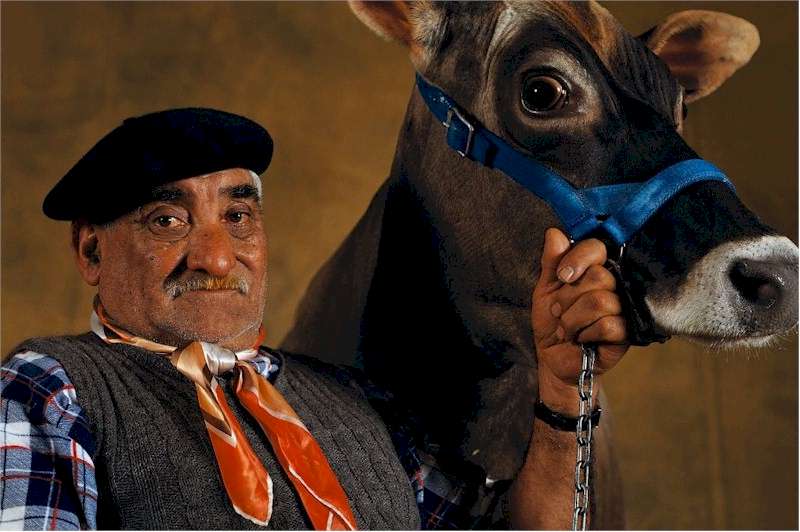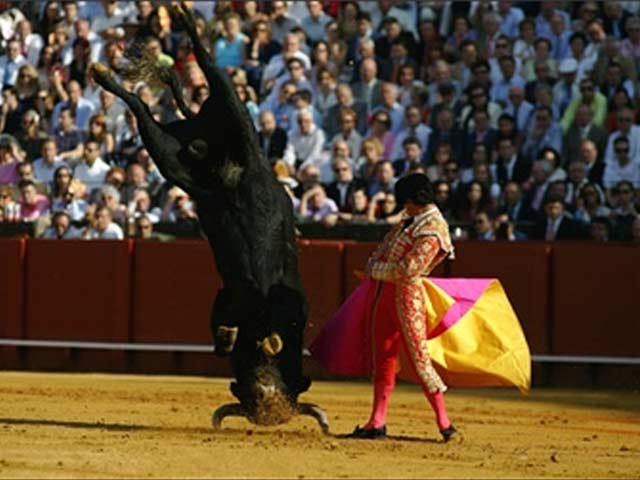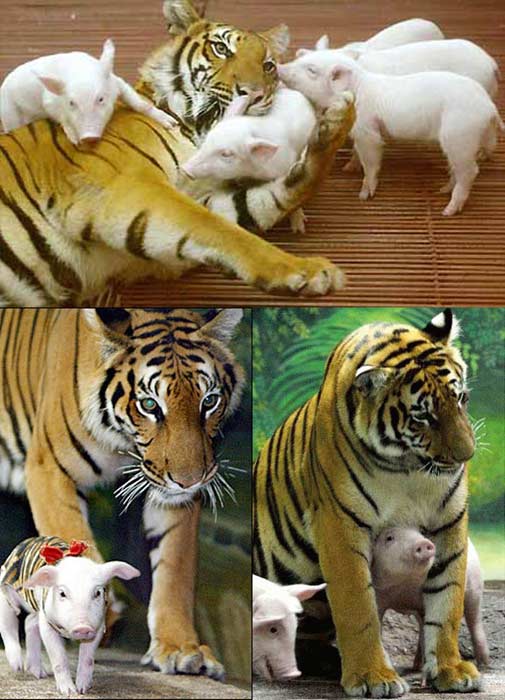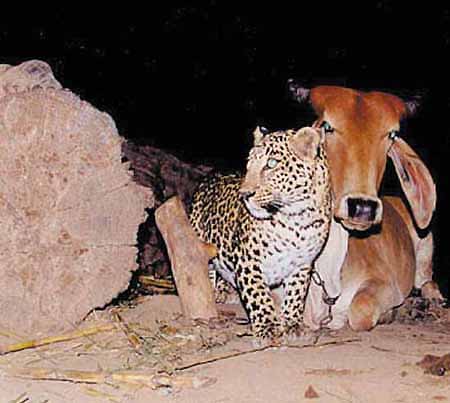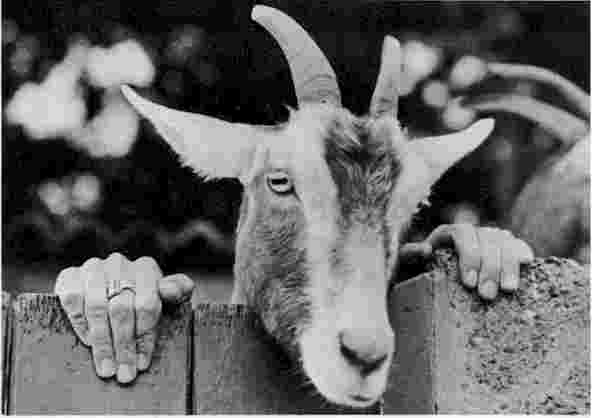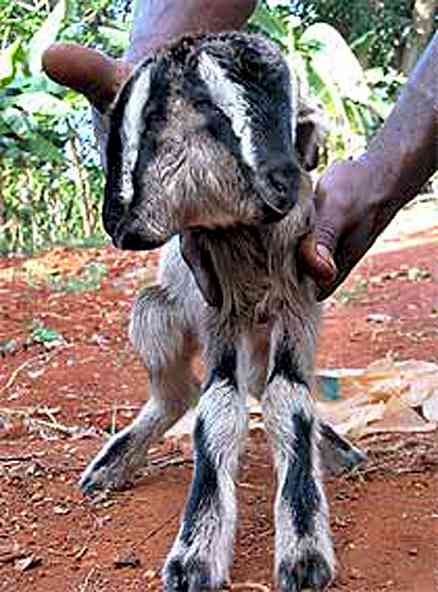How Now? No Cow!
The Cow That Jumped Over the Moon?As a boy I lived on a farm in Canada. On the adjoining farm, lived a girl I was fond of. One day as we sat together on the top rail of the cattle pen we watched a bull servicing a cow. I turned to the girl, with what I hoped was a suggestive look, saying, "That looks like it would be fun." She replied, "Well... she's your cow." - John Kenneth Galbraith There's nothing like sitting back and talking to your cows. - Russell Crowe Holy Cow!According to Reuters, the dazed crew of a Japanese trawler was plucked out of the Sea of Japan earlier this year clinging to the wreckage of their sunken ship. The rescue was followed by immediate imprisonment once authorities questioned the sailors about their ship's loss. To a man they claimed that a cow falling out of a clear blue sky had struck the trawler amidships, shattering its hull and sinking the vessel within minutes. The men remained in prison for several weeks - until the Russian Air Force reluctantly informed Japanese authorities that the crew of one of their cargo planes had apparently stolen a cow wandering at the edge of a Siberian airfield, forced the cow into the plane's hold, and hastily taken off for home. Unprepared for live cargo, the Russian crew was ill-equipped to manage a frightened cow rampaging within the hold. To save the aircraft and themselves, they shoved the animal out of the cargo hold as they crossed the Sea of Japan at an altitude of 30,000 feet. Source: newsletter of The Brevet Club Wellington Inc July 1997 (the incident reportedly happened 4 March 1997, but read the next article below)
What's Not to Love about A-Cow-Falling-from-the-Clear-Blue-Sky Story?by Barbara "playing for high steaks" Mikkelson This legend has been entertaining people for years, and the nationality of the cow has changed throughout the tellings, as has that of the ship it supposedly swamped. A 1993 folklore book refers to this story's appearing in the 1 June 1990 Moscow News. In that version the cow was brought onto the aircraft as a spur-of-the-moment thing and then driven out of the plane as the colder air at high altitudes caused her to become agitated. A similar story shows up in a 1983 folklore book and is said to date to around 1965. In that case the airborne bovine dropped onto the hood of a car in Scotland. The spring 1996 outbreak of this legend came from the tale being passed from the German Embassy in Moscow to the Foreign Ministry in Bonn, and someplace betwixt the two transforming itself from apocryphal legend into news story; it subsequently appeared as such in German newspapers. Russians also tell the falling cow story as a joke. Further complicating the mess was someone's twisting of Reuters' well-researched explanation in April 1996 of how this age-old chestnut had ended up working its way into German newspapers. (It's sad but true - articles that debunk legends are often misinterpreted as news accounts of actual events.) Now "falling cow" stories appearing on the Internet sport this attribution: "According to the Reuters News Service: 'Cows Fly.'" Source: snopes.com Visit their website for unlimited entertainment.
Falling Cow Injures Man in Turkish CafeWho was the guy who first looked at a cow and said, "I think I'll drink whatever comes out of these things when I squeeze 'em!"? - Bill Watterson by Smita P Nordwall A cow fell through a roof of a cafe and knocked unconscious a man playing dominoes in Nevsehir, Turkey. Ethem Sahin thought his friends were kidding when they told him how he ended up in the hospital. The cow apparently wandered from a hillside where it was grazing onto the roof of the cafe, built into the hillside. Sahin was treated for a broken leg and his forehead required seven stitches. Source: USA Today Thursday 12 July 2001
Cows Being Taught to Read in New ZealandCows are being taught to "read" in New Zealand in the hope they can save farmers time and money. Researchers hope they can teach dairy cows to identify which gates to go through to robotic milking machines by using signs. Scientist Jenny Jago says the cows are already starting to understand what the signs mean. "We've got to the stage where they are using the signs to make that distinction as to which gate they should go through," she said. "So what we have to do now is work out what it is in that sign that they are using. Is it the colour that they are using as a cue? Is it the shape that we're giving them?" Source: www.ananova.com Wednesday 18 June 2003
SHE'S Not Bossy, HE Is...
www.yannarthusbertrand.com incredible livestock photos by Yann Arthus-Bertrand. See also:
Cow Escapes Meat Plant, Dodges Cars, TrainGreat Falls, Montana - A black, 1,200 pound heifer jumped a gate at the packing plant at around 5am Thursday and apparently wandered through residential areas. Police received reports at about 9:30am that a cow was in the middle of a busy intersection, so police attempted to catch her. They wedged her between a stock trailer and a fence but the heifer barrelled through the fence toward the river, nearly being hit by a Chevrolet Suburban in the process. It was the first of many near-death experiences. With the police in hot pursuit, the cow ran toward the railroad tracks, darting in front of an oncoming locomotive and briefly giving the police the slip again. Crossing another road, the cow was nearly struck by a semi tractor-trailer. "By then it was a madhouse," said police officer Corey Reeves. "People were coming out of the woodwork to see." When police, animal control officers and slaughterhouse workers surrounded the cow in a park near the Missouri River, the cow jumped into the icy water. As she swam to the west bank of the river, Reeves said she sank lower in the water and was being swept downstream - but she found a sandbar near the river's west bank and walked ashore. "I was totally amazed she was able to swim the river," said Del Morris, the slaughterhouse manager. As police scrambled to head off the cow on the other side of the river, a veterinarian with a tranquilizer gun was called. Pursuers again believed they had the cow cornered at a chain link fence, but the heifer ran through a perimeter set up by officials. The chase began to slow as the cow ran up against several strong fences. Dr Jennifer Evans of Big Sky Medical Centre shot the cow with a tranquilizer dart - it had little effect. Two darts later, the heifer still showed no signs of going down. Next, slaughterhouse workers created a makeshift pen with metal panels that led to a stock trailer. The heifer walked into the trailer at 11:45am and was returned to the slaughterhouse, where she was put into a pen - with a stronger fence - and given food and water. News of the heifer's 6-hour adventures prompted a number of people to offer to buy the animal. Source: news.yahoo.com 6 January 2006
The Secret Life of Moody Cowsby Jonathan Leake Once they were a byword for mindless docility. But cows have a secret mental life in which they bear grudges, nurture friendships and become excited over intellectual challenges, scientists have found. Cows are also capable of feeling strong emotions such as pain, fear and even anxiety — they worry about the future. But if farmers provide the right conditions, they can also feel great happiness. The findings have emerged from studies of farm animals that have found similar traits in pigs, goats, chickens and other livestock. They suggest that such animals may be so emotionally similar to humans that welfare laws need to be rethought. Christine Nicol, professor of animal welfare at Bristol University, said even chickens may have to be treated as individuals with needs and problems. "Remarkable cognitive abilities and cultural innovations have been revealed," she said. "Our challenge is to teach others that every animal we intend to eat or use is a complex individual, and to adjust our farming culture accordingly.” Nicol will be presenting her findings to a scientific conference to be held in London next month by Compassion in World Farming, the animal welfare lobby group. John Webster, professor of animal husbandry at Bristol, has just published a book on the topic, Animal Welfare: Limping Towards Eden. "People have assumed that intelligence is linked to the ability to suffer and that because animals have smaller brains they suffer less than humans. That is a pathetic piece of logic," he said. Webster and his colleagues have documented how cows within a herd form smaller friendship groups of between 2 and 4 animals with whom they spend most of their time, often grooming and licking each other. They will also dislike other cows and can bear grudges for months or years. Dairy cow herds can also be intensely sexual. Webster describes how the cows become excited when one of the herd comes into heat and start trying to mount her. "Cows look calm, but really they are gay nymphomaniacs," he said. Donald Broom, professor of animal welfare at Cambridge University, who is presenting other research at the conference, will describe how cows can also become excited by solving intellectual challenges. In one study, researchers challenged the animals with a task where they had to find how to open a door to get some food. An electroencephalograph was used to measure their brainwaves. "Their brainwaves showed their excitement; their heartbeat went up and some even jumped into the air. We called it their Eureka moment," said Broom. The assumption that farm animals cannot suffer from conditions that would be considered intolerable for humans is partly based on the idea that they are less intelligent than people and have no "sense of self." Increasingly, however, research reveals this to be untrue. Keith Kendrick, professor of neurobiology at the Babraham Institute in Cambridge, has found that even sheep are far more complex than realised and can remember 50 ovine faces — even in profile. They can recognise another sheep after a year apart. Kendrick has also described how sheep can form strong affections for particular humans, becoming depressed by long separations and greeting them enthusiastically even after 3 years. The Compassion in World Farming conference will be opened with a keynote speech by Jane Goodall, the primatologist who founded the study of animal sentience with her research into chimpanzees in the early 1960s. Goodall overturned the then accepted belief that animals were simply automatons showing little individuality or emotions. It has taken many years, however, for scientists to accept that such ideas could be applied to a wide range of other animals. "Sentient animals have the capacity to experience pleasure and are motivated to seek it," said Webster. "You only have to watch how cows and lambs both seek and enjoy pleasure when they lie with their heads raised to the sun on a perfect English summer’s day. Just like humans." Jonathan Leake is the Science Editor Source: timesonline.co.uk The Sunday Times 27 February 2005
On the Horns of a Dilemma
Spanish matador Miguel Abellan performs a pass as a bull does a somersault Source: photos.reuters.com 2 May 2006 Reuters/© Marcelo Del Pozo
Cows Adopt a PigletRouen, France - A wild pig orphaned when hunters killed its mother has found a new family - with a herd of cows where he is suckling happily in northern France. "He arrived in early spring. He's got a warm welcome from the cows," said cattle farmer Andre Vieillard. The young boar, about 10 months old, was taking milk but the cows had to lie down to make sure he could feed. "Apparently he is happy here and as far as I'm concerned will stay with the cattle herd until September," said Vieillard, who is rapidly becoming a celebrity in the village of Fleury-la-Foet along with the piglet and its adoptive family. But Vieillard said he was a little bit worried about what will happen in a couple of months. "Afterwards, the hunters will be back." Source: www.reuters.com Reuters 18 July 2002
"Don't Speak to Me about Your Father, Dear. All I Can Say Is He Was a Slob!"
Tiger cubs at the Sri Racha tiger zoo in Thailand are fed sow's milk to make them placid,
A wild leopard and a cow spontaneously befriend each other in India. The Sriracha Tiger Zoo in Thailand is renowned for its rather bizarre cross-species displays. According to a 2004 article in the Animal Welfare Institute (AWI) Quarterly:
Sources: www.shwa.org, news.yahoo.com, www.funpic.hu Thursday 18 November 2004 and the final comment from hoax-slayer.com kindly sent to me by Alison Blenkinsop. See also:
Don't Drink Your Milk!Processing Is the ProblemThe path that transforms healthy milk products into allergens and carcinogens begins with modern feeding methods that substitute high-protein, soy-based feeds for fresh green grass and breeding methods to produce cows with abnormally large pituitary glands so that they produce three times more milk than the old fashioned scrub cow. These cows need antibiotics to keep them well. Their milk is then pasteurised so that all valuable enzymes are destroyed (lactase for the assimilation of lactose; galactase for the assimilation of galactose; phosphatase for the assimilation of calcium). Literally dozens of other precious enzymes are destroyed in the pasteurisation process. Without them, milk is very difficult to digest. The human pancreas is not always able to produce these enzymes; over-stress of the pancreas can lead to diabetes and other diseases. The butterfat of commercial milk is homogenised, subjecting it to rancidity. Even worse, butterfat may be removed altogether. Skim milk is sold as a health food, but the truth is that butter-fat is in milk for a reason. Without it the body cannot absorb and utilise the vitamins and minerals in the water fraction of the milk. Along with valuable trace minerals and short chain fatty acids, butterfat is America's best source of preformed vitamin A. Synthetic vitamin D, known to be toxic to the liver, is added to replace the natural vitamin D complex in butterfat. Butterfat also contains re-arranged acids which have strong anti-carcinogenic properties. Non-fat dried milk is added to 1% and 2% milk. Unlike the cholesterol in fresh milk, which plays a variety of health promoting roles, the cholesterol in non-fat dried milk is oxidised and it is this rancid cholesterol that promotes heart disease. Like all spray dried products, non-fat dried milk has a high nitrite content. Non-fat dried milk and sweetened condensed milk are the principle dairy products in third world countries; use of ultra high temperature pasteurised milk is widespread in Europe. Other Factors Regarding MilkMilk and refined sugar make two of the largest contributions to food induced ill health in our country. That may seem like an overly harsh statement, but when one examines the evidence, this is a reasonable conclusion. The recent approval by the FDA of the use of BGH (Bovine Growth Hormone) by dairy farmers to increase their milk production only worsens the already sad picture. BGH causes an increase in an insulin-like growth factor (IGF-1) in the milk of treated cows. IGF-1 survives milk pasteurisation and human intestinal digestion. It can be directly absorbed into the human bloodstream, particularly in infants. It is highly likely that IGF-1 promotes the transformation of human breast cells to cancerous forms. IGF-1 is also a growth factor for already cancerous breast and colon cancer cells, promoting their progression and invasiveness. It is also possible for us to absorb the BGH directly from the milk. This will cause further IGF-1 production by our own cells. BGH will also decrease the body fat of cows. Unfortunately, the body fat of cows is already contaminated with a wide range of carcinogens, pesticides, dioxin, and antibiotic residues. When the cows have less body fat, these toxic substances are then transported into the cows' milk. BGH also causes the cows to have an increase in breast infections for which they must receive additional antibiotics. Prior to BGH, 38% of milk sampled nationally was already contaminated by illegal residues of antibiotics and animal drugs. This will only increase with the use of BGH. One wonders what the long term complications will be for drinking milk that has a 50% chance it is contaminated with antibiotics. There is also a problem with a protein enzyme called xanthine oxidase which is in cow's milk. Normally, proteins are broken down once you digest them. However, when milk is homogenised, small fat globules surround the xanthine oxidase and it is absorbed intact into your blood stream. There is some very compelling research demonstrating clear associations with this absorbed enzyme and increased risks of heart disease. Ear specialists frequently insert tubes into the ear drums of infants to treat recurrent ear infections. It has replaced the previously popular tonsillectomy to become the number one surgery in the country. Unfortunately, most of these specialists don't realise that over 50% of these children will improve and have no further ear infections if they just stop drinking their milk. This is a real tragedy. Not only is the $3,000 spent on the surgery wasted, but there are some recent articles supporting the likelihood that most children who have this procedure will have long term hearing losses. You probably are wondering what will happen to your bones and teeth if you stop milk. The majority of the world's population takes in less than half the calcium we are told we need and yet they have strong bones and healthy teeth. Cows' milk is rich in phosphorous which can combine with calcium - and can prevent you from absorbing the calcium in milk. The milk protein also accelerates calcium excretion from the blood through the kidneys. This is also true when you eat large amount of meat and poultry products. Vegetarians will need about 50% less calcium than meat eaters because they lose much less calcium in their urine. It is possible to obtain all your calcium from dark green vegetables (where do you think the cow gets their's from?) - the darker the better. Cooked collard greens and kale are especially good. If you or your child is unable to take in large amounts of green vegetables, you might want to supplement with calcium. f you can swallow pills, calcium citrate has a number of other minerals which your body requires to build up maximally healthy bone. It is much better than a simple calcium tablet - you can take about 1,000 mg a day. For those who already suffer from osteoporosis, the best calcium supplement is microcrystalline hydroxyapatite. t is also important that you take vitamin D in the winter months from November to March. Normally your skin converts sunshine to vitamin D, but the sunshine levels in the winter are very low unless you visit Florida or Mexico type areas. Most people obtain their vitamin D from milk in the winter; so if you stop it, please make sure you are taking calcium with vitamin D or a multi vitamin with vitamin D to prevent bone thinning. ost people are not aware that the milk of most mammals varies considerably in its composition. For example, the milk of goats, elephants, cows, camels, wolves, and walruses show marked differences, in their content of fats, protein, sugar, and minerals. Each was designed to provide optimum nutrition to the young of the respective species. Each is different from human milk. In general, most animals are exclusively breast-fed until they have tripled their birth weight, which in human infants occurs around the age of one year. In no mammalian species, except for the human (and domestic cat) is milk consumption continued after the weaning period. Calves thrive on cow milk. Cow's milk is designed for calves. Cow's milk is the number one allergic food in this country. It has been well documented as a cause in diarrhea, cramps, bloating, gas, gastrointestinal bleeding, iron-deficiency anemia, skin rashes, atherosclerosis, and acne. It is the primary cause of recurrent ear infections in children. It has also been linked to insulin dependent diabetes, rheumatoid arthritis, infertility, and leukemia. Small amounts of milk or milk products taken infrequently, will likely cause little or no problems for most people. However, the American Dairy Board has done a very effective job of marketing this product. Most people believe they need to consume large, daily quantities of milk to achieve good health. NOTHING could be further from the truth. Public health officials and the National Dairy Council have worked together in this country to make it very difficult to obtain wholesome, fresh, raw dairy products. Nevertheless, they can be found with a little effort. In some states, you can buy raw milk directly from farmers. Whole, pasteurised, non-homogenised milk from cows raised on organic feed is now available in many gourmet shops and health food stores. It can be cultured to restore enzyme content, at least partially. Cultured buttermilk is often more easily digested than regular milk; it is an excellent product to use in baking. Many shops now carry whole cream that is merely pasteurised (not ultra pasteurised like most commercial cream); diluted with water, it is delicious on cereal and a good substitute for those allergic to milk. Traditionally made creme fraiche (European style sour cream) also has a high enzyme content. Source: mercola.com See also:
Book Reveals the Grisly Horror of HamburgersNothing will benefit human health and increase chances for survival of life on Earth as much as the evolution to a vegetarian diet. - Albert Einstein by Philip Delves Broughton The grisliest description of fast food ever published is proving a hit with Americans desperate to know what lurks inside their hamburgers, while raising the hackles of the fast food industry. Fast Food Nation by Eric Schlosser offers a deeply disturbing account of the fast food industry. Since 1993, he claims, half a million children in America have been made ill by the E coli bug. If their parents knew what was really in the minced meat found in thousands of hamburgers, tacos and pizza toppings, he argues, they would never take their children to another fast-food restaurant again. Feeding dead cats and dogs to cattle was legal in the United States until 1997, when the government banned the practice because of fears over mad cow disease. Dead horses and pigs, however, are still routinely ground into cattle feed. One quarter of America's minced beef, writes Schlosser, is made from worn-out dairy cattle, likely to be riddled with disease and the meat containing antibiotic residues. The book has been called unduly alarmist by the American Meat Association, which represents packers and processors, and "unfortunate" by the National Council of Chain Restaurants. - Daily Telegraph Source: The Dominion 12 March 2001
Hamburgers Are Ready
Source: keenspot.com
B-a-a-h HumbugThe prototypes of strong sensation: blazing lights, red earth, blue sea, mauve twilight, the flake of gold buried in the black depths of the cypress; archaic tastes of wine and olive, ancients smells of dust, goat dung and thyme, immemorial sounds of cicada and rustic flute. - Robert Hughes
"Pardon me, but MY dung doesn't smell!" Source: Cyclists Please Dismount and Other Photographs from Kodak Limited's "Humour '70" Exhibition published in 1971 by Angus and Robertson (Publishers) Pty Limited (A photographer with a sense of humour...)
A local business was looking for office help. They put a sign in the window, stating the following: "HELP WANTED. Must be able to type, must be good with a computer and must be bilingual. We are an Equal Opportunity Employer." A short time afterwards, a goat trotted up to the window, saw the sign and went inside. He looked at the receptionist and baaaa-ed, then walked over to the sign, looked at it and baaaa-ed again. Getting the idea, the receptionist got the office manager. The office manager looked at the goat and was surprised, to say the least. However, the goat looked determined, so he lead him into the office. Inside, the goat jumped up on the chair and stared at the manager. The manager said: "I can't hire you. The sign says you have to be able to type." The goat jumped down, went to the typewriter and proceeded to type out a perfect letter. He took out the page and trotted over to the manager and gave it to him, then jumped back on the chair. The manager was stunned, but then told the goat "The sign says you have to be good with a computer." The goat jumped down again and went to the computer. He proceeded to activate Excel and typed in a cost calculation spreadsheet, that worked flawlessly the first time. By this time the manager was totally dumb-founded! He looked at the goat and said: "I realise that you are a very intelligent goat and have some interesting abilities. However, I still can't give you the job." The goat jumped down and went to a copy of the sign and put his paw on the sentences that told about being an Equal Opportunity Employer. The manager said: "Yes, but the sign also says that you have to be bilingual." The goat looked at the manager calmly and said, "Meeeow!"
This is what I would call an "elastic" joke - I ran across it on two websites on the same day but the second website had a different version: in it, the goat was a dog. I used this version because I already have an overabundance of articles with dogs as the subject. For a human version, see Please Reapply (from the Humour section).
No Kidding
A man holds a two-headed baby goat in Bauta, a rural town outside Havana, Cuba. Source: stuff.co.nz See also:
For more on animals, including reptiles, crustaceans, arachnids, insects, fish, birds, pets, livestock, rodents, bears, primates, whales and Wellington's waterfront, click "Up"
below to take you to the Table of Contents for this Animals section. |
 Animals
Animals Animation
Animation Art of Playing Cards
Art of Playing Cards Drugs
Drugs Education
Education Environment
Environment Flying
Flying History
History Humour
Humour Immigration
Immigration Info/Tech
Info/Tech Intellectual/Entertaining
Intellectual/Entertaining Lifestyles
Lifestyles Men
Men Money/Politics/Law
Money/Politics/Law New Jersey
New Jersey Odds and Oddities
Odds and Oddities Older & Under
Older & Under Photography
Photography Prisons
Prisons Relationships
Relationships Science
Science Social/Cultural
Social/Cultural Terrorism
Terrorism Wellington
Wellington Working
Working Zero Return Investment
Zero Return Investment